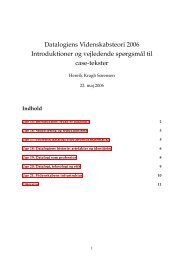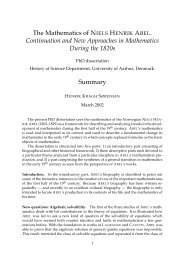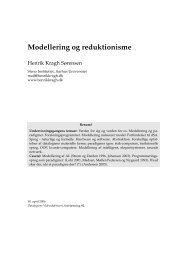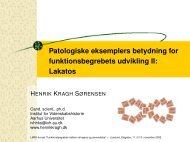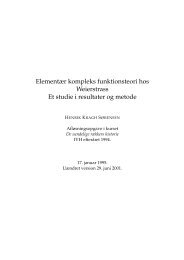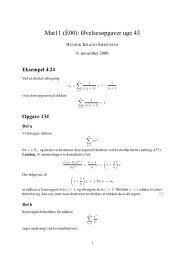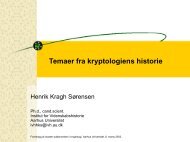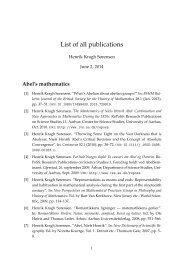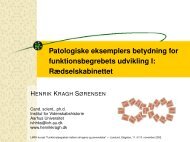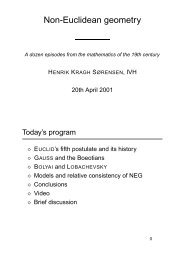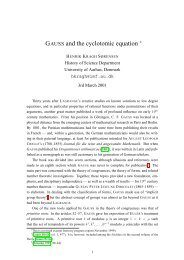A Dozen Episodes from the Mathematics of the Nineteenth Century ...
A Dozen Episodes from the Mathematics of the Nineteenth Century ...
A Dozen Episodes from the Mathematics of the Nineteenth Century ...
You also want an ePaper? Increase the reach of your titles
YUMPU automatically turns print PDFs into web optimized ePapers that Google loves.
A <strong>Dozen</strong> <strong>Episodes</strong> <strong>from</strong> <strong>the</strong> Ma<strong>the</strong>matics <strong>of</strong> <strong>the</strong><strong>Nineteenth</strong> <strong>Century</strong>Week 8: Complex numbers throughout <strong>the</strong>nineteenth centuryHenrik Kragh SørensenHistory <strong>of</strong> Science Department, University <strong>of</strong> Aarhus22nd February 2001http://home.imf.au.dk/hkragh/hom/episoder/LecturesThe lectures in week 8 will treat <strong>the</strong> conceptions <strong>of</strong> complex and hypercomplex numbersthroughout <strong>the</strong> 19th century. Starting with <strong>the</strong> geometrical interpretations <strong>of</strong>complex numbers advocated by Wessel and Argand, both on <strong>the</strong> ma<strong>the</strong>maticalperiphery (Andersen 1999, Wessel 1799), we will turn to <strong>the</strong> pro<strong>of</strong>s <strong>of</strong> <strong>the</strong> FundamentalTheorem <strong>of</strong> Algebra (FTA) by Gauss, and <strong>the</strong> symbolic interpretation <strong>of</strong>complex numbers with Cauchy and Hamilton. Finally, <strong>the</strong> fur<strong>the</strong>r development<strong>of</strong> generalized complex numbers, leading to hypercomplex numbers and algebras,will be traced, (van der Waerden 1985, H<strong>of</strong>fmann 2000).The background literature will consist <strong>of</strong> (Kline 1972, chapters 27.3, 32).ExercisesFor <strong>the</strong> exercises, we will read part <strong>of</strong> William Rowan Hamilton’s Theory <strong>of</strong>conjugate functions or algebraic couples (text 4) as well as a short passage <strong>from</strong>Thomas Hankins’ biography <strong>of</strong> Hamilton (text 5).John and Erik have prepared <strong>the</strong> following guiding questions for <strong>the</strong> exercises:1. What does Hamilton actually introduce in <strong>the</strong> text?2. What is <strong>the</strong> general outline <strong>of</strong> <strong>the</strong> selection? What are Hamilton’s intentions?3. What are <strong>the</strong> differences (<strong>from</strong> a modern perspective) between step and momentcouple?4. What do pure primary and pure imaginary translate into in modern terminlogy?1
5. Where are <strong>the</strong> differences between Hamilton and modern ma<strong>the</strong>matics <strong>the</strong>most/<strong>the</strong> least apparent? The focus is here on <strong>the</strong> presentation <strong>of</strong> ma<strong>the</strong>maticalmaterial.6. Based on <strong>the</strong> introduction, would Hamilton be classified as a pure or as anapplied ma<strong>the</strong>matician?7. Compare Hamilton’s way <strong>of</strong> presenting ma<strong>the</strong>matics to <strong>the</strong> modern tradition.Are <strong>the</strong>y different? How?8. At a central point, Hamilton introduced two constants, γ 1 and γ 2 . What are<strong>the</strong>ir roles? How could <strong>the</strong>y be interpreted <strong>from</strong> a modern perspective (thinkgeometrically).9. Importantly, Hamilton fixed γ 1 = −1, γ 2 = 0. Why? What did he achieve?What were his arguments?10. Based on <strong>the</strong> texts, discuss <strong>the</strong> Kantian foundation <strong>of</strong> Hamilton’s philosophy<strong>of</strong> numbers.ReferencesAndersen, K. (1999). Wessel’s work on complex numbers and its place in history.In B. Branner and J. Lützen (Eds.), Caspar Wessel. On <strong>the</strong> Analytic Representation<strong>of</strong> Direction. An Attempt Applied Chiefly to Solving Plane andSpherical Polygons. Copenhagen: C. A. Reitzel.Gericke, H. (1996). Talbegrebets historie. Århus: Matematiklærerforeningen og Institutfor de Eksakte Videnskabers Historie, Aarhus Universitet. Danish editiontranslated and edited by Kirsti Andersen and Kate Larsen.Guld, T. L. (1997). Hamilton og kvaternionerne. Speciale, Institut for de EksakteVidenskabers Historie, Aarhus Universitet, Aarhus.Hamilton, W. R. (1837). Theory <strong>of</strong> conjugate functions, or algebraic couples; witha preliminary and elementary essay on algebra as <strong>the</strong> science <strong>of</strong> pure time. InThe ma<strong>the</strong>matical papers <strong>of</strong> Sir William Rowan Hamilton, Volume 3, pp. 3–96.Cambridge: at <strong>the</strong> University Press. First published Trans. Roy. Irish Acad.vol. XVIII (1837), pp. 293–422. Read on 4 November 1833 and 1 June 1835.H<strong>of</strong>fmann, M. (2000, June). Fra tal til algebraer. Den britiske begyndelse i1830’erne og aspekter af den tyske fortsættelse op til 1890. Speciale, Institutfor Videnskabs–historie, Aarhus Universitet, Aarhus.Kline, M. (1972). Ma<strong>the</strong>matical Thought <strong>from</strong> Ancient to Modern Times. Oxford:Oxford University Press. Reprinted in three volumes 1990.van der Waerden, B. L. (1985). A History <strong>of</strong> Algebra. From al-Khwārizmī to EmmyNoe<strong>the</strong>r. Berlin, Heidelberg, New York, Tokyo: Springer-Verlag.Wessel, C. (1799). Om Directionens analytiske Betegning, et Forsøg, anvendtfornemmelig til plane og sphæriske Polygoners Opløsning. Nye Samling af detKongelige Danske Videnskabernes Selskabs Skrifter 5, 469–518.2



